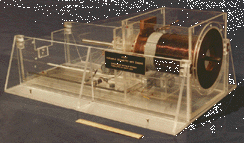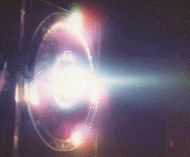

MY ELECTRIC ROCKET ENGINE Discussion with pictures of the advanced-concept rocket engine I worked on for the Air Force
(Click on main site to browse 70 other topics ranging from exotic kaleidoscope designs to the strange world of lucid dreaming.)
In
late January of 2004 I received an email from someone who read my
biography and asked that I post some information on the electric
rocket engine I had mentioned in the bio. This page was written for
him and anyone else that might be interested.
It's called a magnetoplasmadynamic (MPD) thruster and I had the great fortune to spend several years at the Air Force Rocket Propulsion Laboratory at Edwards Air Force Base in southern California working on it. MPD thrusters have been around for many years. Mine was only different in that I developed a design that allowed some of the critical components to be adjusted so that its performance could be optimized. Here's what it looked like:

For scale the wood ruler is 12 inches long.
Here's what it looked like when firing:

What's different about MPD thrusters from normal rocket engines is that instead of producing thrust by burning chemicals, MPD thrusters create thrust by using electric currents and magnetic fields. These engines are probably close relatives to the impulse engines of Star Trek fame. The difference is that MPD thrusters exist and work whereas the impulse engines are strictly science fiction.
How
does an
MPD thruster work?
Imagine you have two parallel metal bars with a third round bar laid across them. Now attach a huge direct current source to the parallel bars so the current flows up one side, across the round bar and down the other side. You'd have something like this:

Anytime you make current flow down a conductor it creates a magnetic field. Wrap your right hand around the conductor so that your thumb points in the direction of the current and your fingers will point in the direction of the magnetic field, which curves around the conductor. In the case above, the current in the lower parallel rail creates a magnetic field that goes up between the two bars. The current on the upper parallel bar is going in the opposite direction so it also creates a magnetic field that goes up in the space between the two bars. This means that the two magnetic fields add together to form a strong field.
Now look at the bar laying across the two parallel bars. The current travels along it perpendicular to the magnetic field between the two parallel bars. One of the fundamental laws of nature state that when this is the case the magnetic field will try to force the current, and the conductor carrying it, away. In the case above, this means that the cross bar will have a force trying to push it along the rails. If the current is high enough the cross bar will roll or slide down the rails. If you really pump up the current the cross bar will accelerate so fast that when it reaches the end of the rails it'll keep on moving, flying through the air on it's momentum until air resistance slows it down. This is the idea behind the weapons known as rail guns. The Army is looking at ways to make these powerful enough to mount on tanks. But, back to the more peaceful application of space propulsion.
Okay, you've got the cross bar moving. If you are in space and the rails are attached to you spaceship, then as you push the cross bar away it'll resist being accelerated with the result that it will push back on you. It's the old "every action has an equal and opposite reaction" thing you heard back in high school science class. The higher you crank up the current, the faster the cross bar is pushed away and the harder it pushes back. This pushing back is the thrust that will cause your space ship to accelerate.
As you push more and more current through the cross bar to create as much thrust as possible, at some point it will get so high that that the bar will heat and melt or even vaporize. It doesn't mater, current will still travel through the liquid or gaseous metal and the magnetic fields will push it away to create thrust. If the space between the rails was filled with gas and the voltage between them was high enough, the gas would ionize and conduct electricity just like vaporized metal.
That's all an MPD thruster is: an engine that passes current through two conductors and a gas to create thrust. To keep the gas between the conductors so that it can be ionized and accelerated, instead of two rails the thruster consists of a central rod (cathode) and an outer cylindrical tube around it (anode). The gas can be anything because the currents and voltages used are so high that anything will be ionized enough to become a conductor. In the laboratory argon is usually the gas of choice, but everything from hydrogen to xenon has been used.
Why
bother developing electric rocket engines?
All of the energy for producing thrust in chemical rockets comes from the chemical energy stored in the chemicals. The problem is that this really isn't very much energy so we have to use a lot of fuel. Consider the moon rocket, 95 percent of its take off weight was fuel. If we could find a way to get more energy into the fuel we'd need less of it. By adding energy from an external source we can pump as much energy into the propellant as we want. In so doing it's possible to reduce the amount of propellant needed for a given task by as much as a factor of ten. That can be enough to more than make up for the weight of the power supply required to provide the electricity.
Sounds
great... then why doesn't the space shuttle use electric engines?
First, electric rocket engines only provide low thrust. MPD thrusters are the super heavyweights in the electric propulsion world and a typical one (8 inches in diameter and six long) only produces 50 pounds of thrust. In space this is fine because there are many missions where long, slow, constant thrust will actually get the mission accomplished faster than a short burst of high thrust followed by a long coast. This isn't the case for the space shuttle.
Second, we don't have light weight power supplies capable of working in space that can provide the power needed to operate an MPD thruster. A small thruster like the one described above requires three megawatts (typically 150 volts and 20,000 amps) of electric power. The only systems capable of providing that in space would be nuclear reactors and they are far too heavy.
So
then why is the Air Force developing these engines when they can't
do anything?
Because the military isn't as short sighted as people like to think. The top brass understand that it sometimes takes decades to develop a useful system. If we don't start now we'll never have them when the power systems are finally available.
Are
there any other kinds of electric thrusters?
Many. Resistojets and arc jets use electric heat to expand and accelerate gas to create thrust. Dozens of these engines are currently in orbit right now helping satellites maintain their positions. Ion engines use electrostatic fields to accelerate ions to create thrust. These have been used on a couple of deep space missions. There are several other electric thrusters that haven't flown in space that use different electrical principles to create thrust. MPD thrusters are unique in that they are the superheaviweights of the electric propulsion universe. Whereas most electric thrusters only produce a few ounces of thrust, a single MPD engine can generate over 50 pounds of thrust from and engine that's small enough to fit in a shoebox.
Who
is doing this research?
The three big countries in electric propulsion are the US, Germany and Japan. In the US Princeton is the focal point but JPL and the Air Force are also heavily involved.
What's
the biggest problem with conducting research on electric thrusters?
Other than learning the complex theories governing plasma physics, the biggest problem is test facilities. Electric rocket engines are designed to work in space under vacuum conditions. Creating these conditions on earth requires enormous vacuum tanks and pumping systems that are incredibly expensive.
What
is
research on these rockets trying to accomplish?
It's easy to get any of these engines to produce thrust. What most people are working on is finding the optimum electrode shape to maximize electric efficiency and discovering materials that maximize thruster life. The currents are so great in many of these engines that the electrodes tend to erode.